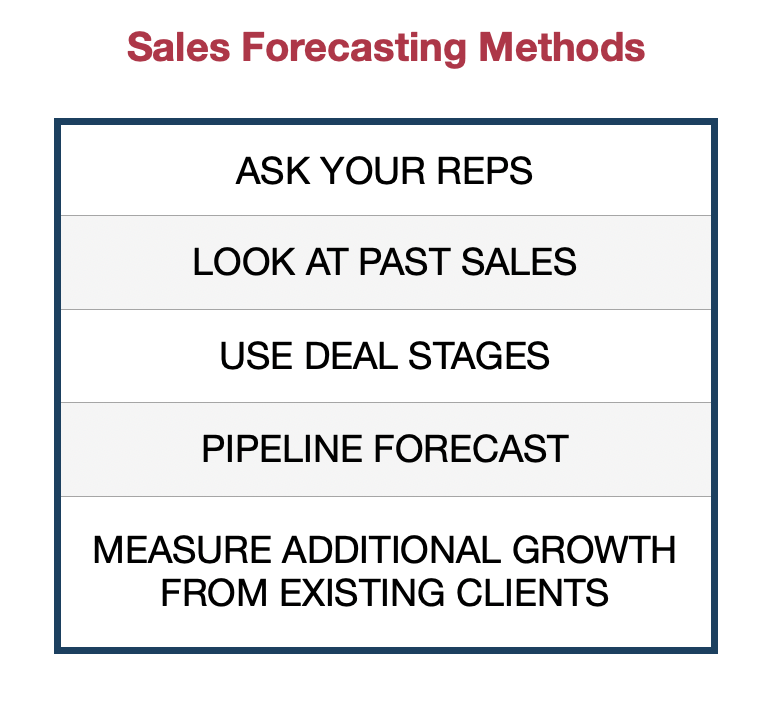
Focusing on the day-to-day activities or weekly/monthly sales targets your team needs to hit is important for every sales leader. But you also need to be keeping an eye on the future for your sales team as well. That’s where sales forecasting comes in. Creating accurate sales forecasts can help you make the right decisions now to set up your team and your business for success in the future.
And in times of economic uncertainty, this is more important than ever.
However, creating realistic sales forecasts is harder than it looks for even experienced sales leaders. That’s why in today’s blog, we’ll cover what there is to know about creating a sales forecast for your company, with a goal of growth in mind.
Components of Sales Forecasting
What is a Sales Forecast?
A sales forecast predicts what a sales rep, team, or business will sell in a fixed period of time. They’re typically done on a weekly, monthly, quarterly, or annual basis. Sales forecasts are vital to any organization because they let you spot potential issues before they become big problems.
With accurate sales forecasting, you can notice if your sales team is trending well below their quota amount and have time to take action and figure out what’s going on.
Discovering these problems right away, instead of waiting until the next month or quarter, can allow you to correct the course before it impacts the bottom line of the organization. Making this a sales best practice helps keep everyone on track in real-time.
It’s also highly motivating for your teams to see if they’re on pace to hit their upcoming targets. Hence, sales forecasts can help get them excited to succeed.
Sales forecasts also help leaders make smart and informed decisions about hiring, goal-setting, budgeting, and your overall sales strategy. If your forecasts are predicting a big bump in opportunities in the next year, you can make a decision to hire another sales rep to meet anticipated demand. If forecasts are trending down, you can invest in additional marketing instead.
Sales Forecasting Methods

Here are a few common methods of sales forecasting:
Asking Your Reps
This is a method many sales managers pick because it’s easy – just ask reps when they expect a deal to close, and how much it will close for. This is obviously an important thing to do, but it’s not the best way to build a sales forecast.
In fact, the downfall to using this method is that it’s a fast way to get an inaccurate sales forecast. Sales reps tend to overestimate, and there’s no real repeatable or scalable action you can add as part of your sales process.
Looking at Past Sales
Tracking sales and looking back at your year over year numbers can help you get a rough estimate of how your team is likely to do in the future. However, your historical sales data doesn’t take into account any new hires you’ve made, shifts in the market, or new and hungry competitors.
Using Deal Stages
This is another simple but fairly effective method of sales forecasting.
For this one, you assess the probability of closing a deal at each stage in your sales process, and multiply that probability by the size of an opportunity, or all of the opportunities in that stage, to predict revenue.
However, to make this method more accurate, you must constantly weed out old opportunities that are well past their closing dates and make sure the deals in each stage are viable and accurately valued. Tracking how long opportunities have been in the sales cycle will help you remove those deals that have been in the pipeline too long and so are unlikely to close.
This method can lead to accurate forecasting as long as timely, correct data about deals is logged regularly in the CRM.
Pipeline Forecasting
Getting more sophisticated now, this forecasting method assesses opportunities in your sales pipeline by looking at a number of factors like:
- deal type
- deal stage
- age
This forecasting method is highly accurate for predicting future sales. However, it does require custom tools that can analyze your pipeline effectively.
Measuring Additional Growth from Existing Clients
All of the forecasting methods mentioned thus far apply mostly to new business/new client growth.
There is another element to consider when forecasting your total sales/pipeline. Look at your existing business and determine how much recurring revenue you can expect from current customers. Then figure out how much growth (additional revenue) you can expect from these same customers.
Doing these activities will then tell you how much new business with new customers you will have to sell to reach your monthly/annual revenue targets.
How to Incorporate Accurate Sales Forecasting
Predicting future sales and opportunities is highly valuable to your business, but it’s also tricky to get it right. Forecasting accuracy is important because otherwise, you’re just guessing. And unfortunately, guessing can lead to uninformed decisions and unfounded optimism about revenue growth and total sales numbers.
But there are a few factors that can help you create accurate sales forecasts.
Having an established sales process that your whole team follows helps you increase the likelihood of accurately predicting what actions will lead to certain outcomes. We’ve said this before, but it is worth repeating again.
For example, maybe you know that your reps all have a killer script that closes deals at a high rate once you reach a certain step in the process. This steady rate will help you accurately predict how future prospects will react as well.
Setting sales quotas for every team member and department also helps keep forecasts on track and accurate. These quotas will give you a baseline to compare your forecasts with to see if you need to make adjustments.
Predictions help manage the steps for growth
And finally, keep future changes in mind:
- Are you introducing new products or services soon?
- Are you opening up new territories or markets soon?
- For your products or services, are you generally in a growth cycle, a steady period or is demand lessening?
- Is the economy slowing down or speeding up?
- What does the competitive landscape ahead look like?
- Are you launching a new marketing campaign?
Looking at these factors as well as your pipeline and historical sales data will help you create more accurate forecasts for the future. This is because you’re taking into account multiple factors that can influence your next quarter or year.
Creating Growth Through Sales Forecasting
When it’s done right, accurate sales forecasting can help your business grow significantly and sustainably. You’ll be able to look at upcoming opportunities clearly and then adjust your sales strategy to reflect what’s happening now in your business and the market. But the best part is the ability to track your progress as you go.
Do you want to get all the results of sales forecasting but aren’t sure where to start or what method to use? At 360 Consulting we specialize in strengthening your sales and sales forecasting with systems that work. We can help you fine-tune your sales process, set smart goals, and create the thoughtful sales forecasting strategy that works for your business.
Schedule your free consultation today to learn more about how we can help you break your sales records.
